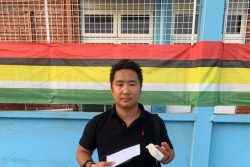Guyana’s country progress report for the past two years, which will be submitted to UNGASS later this month, cites evidence the AIDS epidemic has been progressively decreasing among the general population, but it also points to the increasing feminization of the disease.
The sex ratio (male to female) in the country indicates a change from 1.16 percent in 2000 to 0.91 in 2008, and 1.05 in 2009. The progress report discloses that between 2003 and 2008, the annual number of reported cases of HIV has been consistently higher among females.
Health Minister Dr Leslie Ramsammy yesterday endorsed the UNGASS report unlike previous years when he had called for changes to be made. It was just on Thursday that Ramsammy commented on the vulnerability of women and young girls while addressing HIV at a stakeholder’s workshop. He had said that power differentials in intimate relationships and sexual violence are placing the burden of the epidemic on the shoulders of women and girls.
The minister emphasized then that the new national strategy, which is to be launched next year, must also effectively address the issue of vulnerability of women and young girls. Ramsammy had also called for efforts to be made to integrate the prevention of HIV transmission to young women and also seek to stop mother-to-child transmission within the pursuit of Millennium Development Goals.
Ramsammy said the 2010 UNGASS report reflects that Guyana has made progress in combatting HIV and he noted that it provides the health sector with an impetus to do better. He said Guyana has come a long way over the years, but he pointed out that programmes which are implemented must be sustained.
The United Nations General Assembly Special Session (UNGASS) on HIV/AIDS offers countries an annual forum to review their progress in meeting commitments which were made in 2001, and which are set out in the UNGASS Declaration of Commitment, 2001.
Guyana’s 2010 country report indicated that progress has been made over the last six years with encouraging signs that the HIV prevalence among the most-at-risk populations is beginning to decline. It said HIV prevalence was at 1.14 percent in 2009 down from 1.15 in 2008. HIV prevalence has also been reduced among at-risk populations such as Female Sex Workers (FSW) and Men who have Sex with Men (MSM), but while there has been a sharp decreased among FSWs, only a slight decline was reported among MSM.
The report said that the proportion of deaths attributed to AIDS has progressively decreased since 2002, when it was 9.5 percent to 4.7 percent in 2008. The statistics point to the actual number of AIDS related deaths as reducing from 475 in 2002, to 360 in 2005, 298 in 2006 and 239 in 2008.
According to the UNGASS report, the draft HIV legislation which was developed is currently being finalized by the Attorney General’s Chambers for tabling in Parliament. The draft HIV legislation addresses a range of issues including the protection of people living with HIV from discrimination.
The VCT programme has been expanded to increase access and geographic coverage, the report said, noting that the country has gone from 44 sites in 2007 to 62 sites in 2008 and 70 sites in 2009. A total of 63,879 persons (37,028 females and 26,848 males) received counselling and testing in 2008 and this was increased to 85, 554 persons (48,042 females and 37, 512 males) last year.
The report stated also that access to a safe blood supply was expanded within the last two years, in addition to substantial work being completed to ensure safe injections and minimize the risk of needle stick injury.
But challenges still remain and Programme Manager of the National AIDS Programme Secretariat (NAPS) Dr Shanti Singh outlined some yesterday. She said the health sector continues to grapple with the issue of retaining trained staff, particularly in outlying areas. She noted that persons infected with the disease are still waiting too long before they access treatment as evident in the low CD4 count which some patients show up at the treatment centres with.
Singh said stigma and discrimination is still a problem among health care workers and this is erecting barriers and preventing access to treatment and services. She added that stigma and discrimination also remain in homes and at workplaces. She said too that there is limited ongoing review of policies to determine those that contradict the national AIDS control policy.








